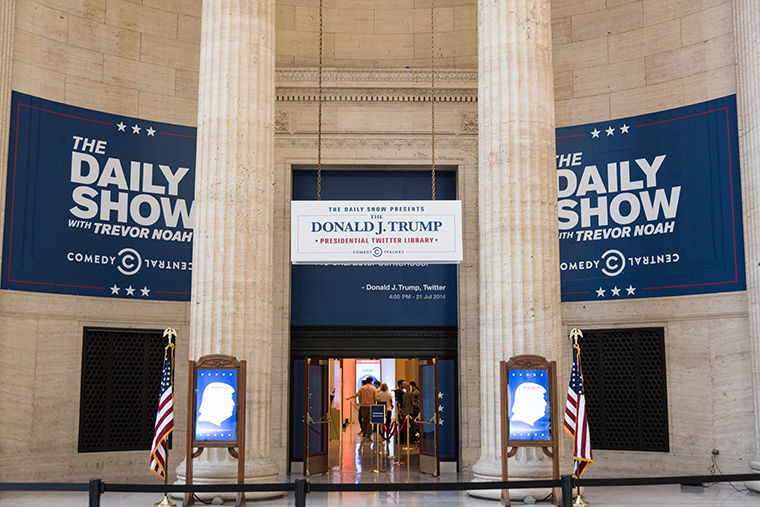‘The Daily Show,’ Presidential Twitter Library visit Chicago
October 20, 2017
One wall of “The Daily Show with Trevor Noah’s” Donald J. Trump Presidential Twitter Library, displays a timeline of silhouetted former presidents experimenting with communication modes from their era.
George Washington sits at a desk, writing. Franklin Delano Roosevelt has a radio microphone in front of him. John F. Kennedy stands in front of a TVcamera. At the end of the line, his shoulders hunched, is President Donald Trump, typing away on his smartphone with a tweet ready to go.
According to “Daily Show” Correspondent Desi Lydic, The Donald J. Trump Presidential Twitter Library, open Oct. 20–22 at 225 S. Canal St., looks at what Trump’s inevitable presidential library is likely to commemorate instead of the usual trove of books, memoranda and memoirs.
“At a field meeting, one person threw out this idea of ‘What is his presidential library going to actually look like?’” Lydic told The Chronicle. “We started envisioning what it would look like, and [decided that] of course it would be a Twitter library full of disappointments.”
The disappointments include “The World According to Trump,” a map of the world with Trump’s tweets appended to the countries who have ticked him off.
Another exhibit, which Lydic said is her favorite, is a faux-Oval Office with a golden toilet front and center, in which visitors can don a Trump-esque wig, bathrobe and “Make America Great Again” hat before sitting on the toilet and tweeting from the “Commander-in-Tweet” Twitter account.
“I myself am a toilet tweeter,” Lydic said, “as I believe our president is.”
The Presidential Twitter Library’s pop-up comes on the heels of “The Daily Show” taping in Chicago Oct. 16–19 instead of its usual set in New York.
“People have used Chicago as a litmus test,” said “Daily Show” correspondent Dulce Sloan. “People have turned Chicago into an unnecessary underdog. We think it’s getting stepped on. [There are] issues, but not more issues than there are in New Orleans, or Baltimore, or Atlanta, or New York. Anywhere that has a population that’s underserved [and] highly segregated like every city in the country [has issues].”
Throughout the week, the show had a prevailing theme of teasing Chicago and then acknowledging the efforts being made to improve the city. In the episode that aired the night of Oct. 17, host Trevor Noah’s monologue taunted the “Second City” for recently coming in first as the “rattiest city” in a rating by Orkin.
Correspondent Ronnie Chieng did a field segment expressing his disgust for deep dish pizza, then highlighted a program in Cook County Jail for whichinmates master the craft of pizza making—specifically thin crust.
The episode concluded with an interview with former U.S. Secretary of Education Arne Duncan and former street gang leader Curtis Toler discussing their program, CRED, which mentors underprivileged youth.
The creative process behind field pieces like Chieng’s is incredibly involved, Sloan explained. An initial pitch must be approved before the correspondents can gather resources, such as interviews, for the story. A more detailed pitch must then be approved before production.
The production process includes many players beyond the correspondent, Sloan added.
“You have to have the [crew] to shoot it, the field producers, the PAs on site,” she said. “There’s all of these moving parts that go into doing everything.”
Chieng outlined three jobs that come into play behind the scenes for “Daily Show” creative operations: comedy writers, studio producers and field producers.
Comedy writing, Chieng said, is self-explanatory, but studio producers and field producers both call for certain talents and experiences.
“[A studio producer’s] job is to process the news, edit out clips and present clips to everyone,” he said.”[You have to have] an eye for funny clips and understand what plays on television.”
Field producers require a diverse skillset, Chieng added.
“We go out to film field pieces,” he said, “and they are often [the] directors, sometimes cinematographers, writers and producers, therapists, at the same time.”
These invisible positions are the kind that many Columbia students study and train for, and Sloan said that such education and training has informed her career in ways she did not anticipate.
“I didn’t know I would have to be doing voiceovers for the field pieces,” she said, “but I had taken private voiceover lessons years ago. I did not know that when I had to do my desk piece, I would have to read off of a teleprompter, but I had taken teleprompter training years before that. All of these different things that I’ve done in the course of my career have helped.”








